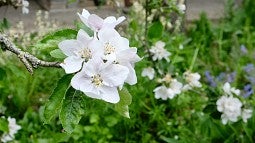A generation of UO students got their hands dirty and learned to grow food at the Urban Farm. Along the way, they gain knowledge about food security issues and sustainability, and they get to take home a bit of the farm’s bounty after each class.
But this spring, with most students gone from campus and learning remotely because of the COVID-19 pandemic, farm managers have had to find new ways to run the farm and distribute its bounty in the community.
“I’m heart broken,” said Harper Keeler, director of the Urban Farm and senior instructor in the Department of Landscape Architecture. “It’s so beautiful here. The flowers are going off, the trees are in flower, we put honeybees in last weekend.”

“We’ve been donating food there forever,” he said. “Any bit helps, especially fresh organic food from just down the street.”
Ryan Baker-Fones, chaplain at Episcopal Campus Ministry, which runs the Student Food Pantry, said it was “awesome” to get produce from the Urban Farm.
“The students love it because it can’t be much more local and much more fresh,” he said.
The Urban Farm, established in 1976 on the north side of Franklin Boulevard, is used as an applied research facility and as an outdoor classroom to teach organic gardening.
Part of the landscape architecture program in the College of Design, the class grows close to 100 different crops and produces up to 20,000 pounds of produce each year, Keeler said. About 140 students work the farm in fall and spring terms, and 25 to 30 during summer term.
Students majoring in more than 95 disciplines have taken the Urban Farm class, he said. Most students are environmental study majors.

Right now, leeks, spring onions, swiss chard, kale, lettuce, arugula, asparagus and beets are going great, and Keeler has begun planting brassicas for later in the season. Tomatoes, peppers, eggplants, cucumbers and zucchini are growing in the greenhouse.
Mason bees and honey bees are doing their thing, and the 60 to 70 fruit trees are in blossom.
Soon corn will be part of the crop. Keeler has received permission to grow sweet corn for the food pantry on part of a field next to a research greenhouse that won’t be used this summer.
Last week, Keeler delivered about 75 leeks and about eight buckets of Swiss chard, kale and mixed greens to the food pantry. He expects that number to double this week. The pantry also gets staples from Food for Lane County, but fresh, local organic vegetables are hard to beat, Keeler said.
“Nutrient-rich veggies are always in short supply,” he said. “It’s not just about calories. It’s about good food and community.”
—By Tim Christie, University Communications


